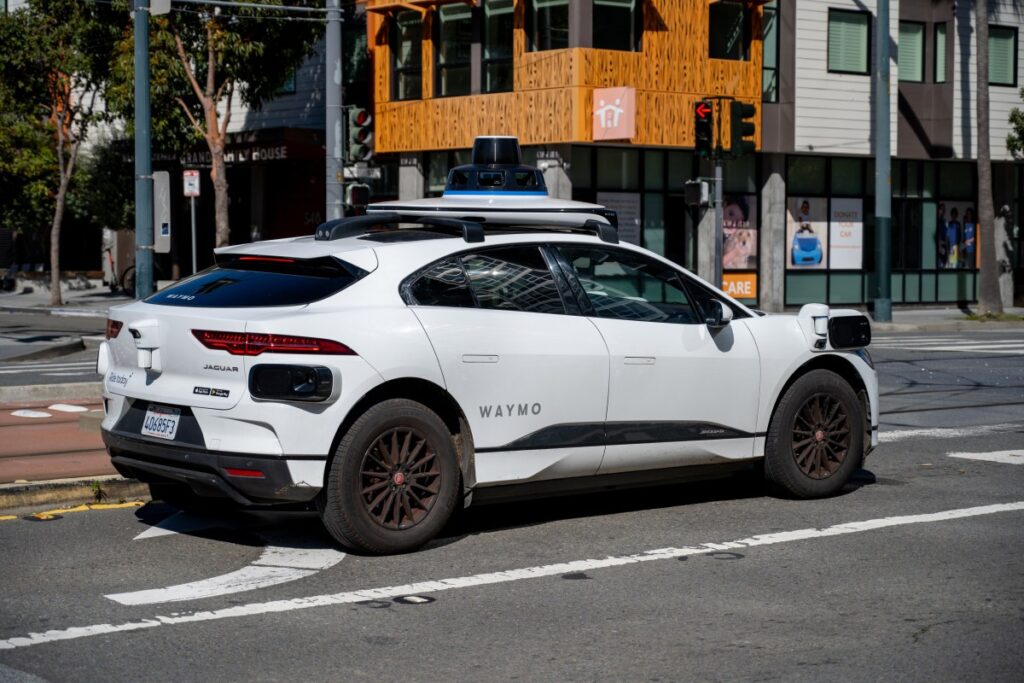A central premise of robotaxis is that high usage and lower labor costs will ultimately make it a cheap transportation option. That is still far from true, but now there’s some data that gives us an idea of by how much.
Obi, an app that aggregates real-time pricing and pick-up times across multiple ride-hailing services, has just published what it’s calling the “first in-depth examination of Waymo’s pricing strategy.” The company found Waymo’s self-driving car rides to be consistently more expensive than comparative offerings from Uber and Lyft — and it doesn’t seem to matter.
The report, shared exclusively with TechCrunch, is based on a month’s worth of data collected between March 25 and April 25 in San Francisco, California. Obi pulled nearly 90,000 “offer records” from Waymo, Lyft’s “standard” offering, and UberX in order to compare price and ETA. It then compared ride requests from the same times and routes. Obi found Lyft offered the lowest average price at $14.44. Uber was next at $15.58. Waymo’s average price across the month’s worth of data was $20.43.

Ashwini Anburajan, Obi’s chief revenue officer, told TechCrunch this was somewhat surprising given the early popularity of Waymo’s service. Waymo said in May it’s providing 250,000 paid trips per week across its first four cities. Higher pricing has apparently not dimmed that excitement.
“Colloquially, there is an idea that autonomous vehicles are something that will erode driver jobs and put drivers at risk. And I think the irony of what we’ve seen is that it’s actually quite expensive to run an AV, and that that’s not going to be happening, at least in the near term,” she said.
At peak hours, Obi found Waymo’s average price to be about $11 more expensive than a Lyft and nearly $9.50 pricier than an Uber.
“I didn’t expect consumers being willing to pay up to $10 more,” Anburajan said. “I think [that] speaks to a real sense of excitement for technology, novelty, and a real preference to sometimes be in the car without a driver.”
Obi found that not only was Waymo more expensive, but there was greater variability in its pricing than with Uber or Lyft.
Anburajan said one explanation is that Waymo’s pricing model is not as sophisticated. Uber and Lyft, she said, have had more than a decade to refine how they price rides. Those platforms are also a bit more dynamic, with drivers clocking in and out on their own time, or joining or abandoning the gig work altogether.
Waymo, meanwhile, has a mostly fixed but slowly growing supply of vehicles (though the pace of that growth may soon accelerate). This has led to what Anburajan said is more of a “pure supply and demand” pricing scheme.
That has two big impacts on customers. One is that short trips tend to cost more than longer ones. Obi found that Waymo rides cost roughly $26 per kilometer if the ride stays under 1.4 km.
This was true of the Uber and Lyft rides, too. But Obi found the shortest Waymo rides were priced 41.48% and 31.12% higher than Uber and Lyft, respectively. That gap shrunk as the rides got longer. In rides lasting between 4.3 km and 9.3 km, a Lyft cost $2.60 per km, an Uber cost $2.90 per km, and a Waymo cost $3.50 per km.

The other impact is that longer wait times equals more expensive trips. After all, sending a car a long way to pick up a customer means it will perform fewer high-margin, short-distance rides.
That still isn’t discouraging Waymo customers, Anburajan said, even though Obi found Waymo to have a higher variability in wait times.
In addition to the data-based deep dive, Obi also surveyed riders in Los Angeles, San Francisco, and Phoenix, Arizona to get a better understanding of what might be driving these trends.
The company found that 70% of users who had taken a Waymo ride said they preferred a driverless car to a traditional rideshare or taxi.
Despite that enthusiasm, Obi found that safety is still a big concern for riders. Of those surveyed, 74% said safety is their biggest concern about robotaxis. Nearly 70% of respondents said they think there should be some form of remote human monitoring of the rides (something that is already a common practice).
Perhaps even more striking is how people answered a question about whether they would be willing to pay more for a Waymo. Nearly 40% said they’d pay “the same or less.” But 16.3% said they’d pay less than $5 more per ride. Another 10.1% said they’d pay up to $5 more per ride. And 16.3% said they’d pay up to $10 more per ride.
Anburajan said responses like those help further explain Waymo’s pricier rides.
“There’s something about being in the car alone” that is winning customers over, she said. “It is there for you to, like, kind of live in a little bubble and get from point A to point B, and be very comfortable doing so.”

